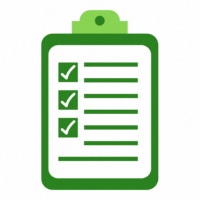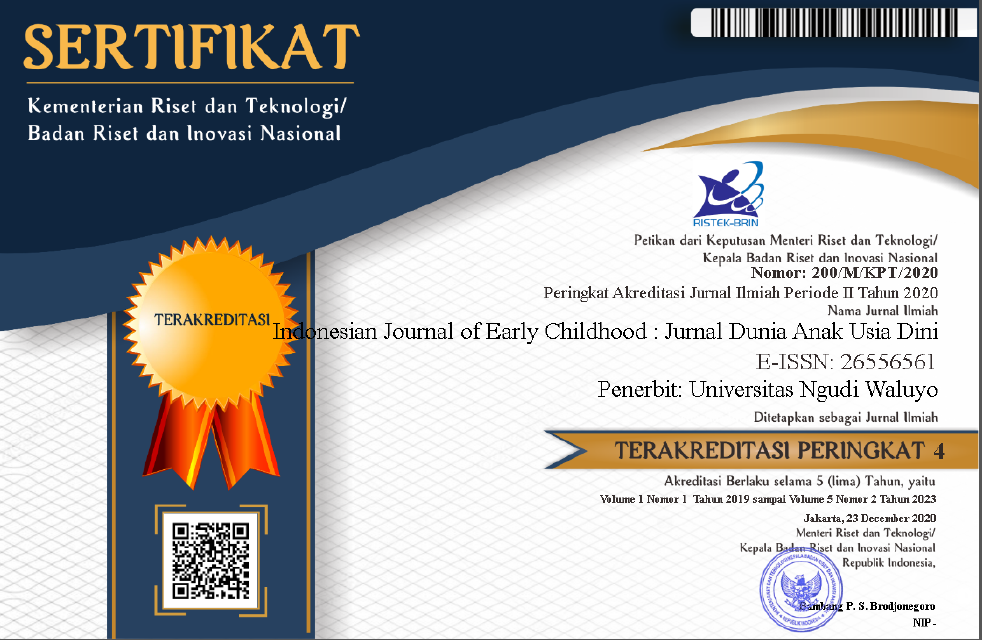Manajemen Sarana dan Prasarana di TK Al Fatah
Facilities and Infrastructure Management at Al Fatah Kindergarten
DOI:
https://doi.org/10.35473/ijec.v7i1.2792Abstract
Management of facilities and infrastructure is an important component in early childhood education (PAUD). Adequate and well-managed facilities and infrastructure can support children's learning and development processes. The purpose of this research is to determine: (1) Planning of facilities and infrastructure, (2) Procurement of facilities and infrastructure, (3) Distribution of facilities and infrastructure, (4) Maintenance of facilities and infrastructure, (5) Inventory of facilities and infrastructure, (6) Elimination facilities and infrastructure, and (7) Evaluating facilities and infrastructure at Al Fatah Kindergarten. This research is qualitative research with the type of field research (field research), with data collection techniques using observation, interviews and documentation methods. The research results show that: 1) Planning for facilities and infrastructure needs at Al Fatah Kindergarten is managed well and in accordance with school needs; 2) Procurement of facilities and infrastructure is always carried out according to the decision of the school principal; 3) Inventory is carried out once a year; 4) Distribution of facilities and infrastructure is carried out directly; 5) Maintenance of Facilities and Infrastructure is carried out in the short and long term; 7) Removal of Facilities and Infrastructure is carried out by looking at the condition of the goods, and if the goods are not suitable for use they will be deleted; 8) Evaluation is carried out by involving the student's parents.
ABSTRAK
Manajemen sarana dan prasarana merupakan salah satu komponen penting dalam pendidikan anak usia dini (PAUD). Sarana dan prasarana yang memadai dan terkelola dengan baik dapat mendukung proses pembelajaran dan pengembangan anak. Tujuan penelitian ini untuk mengetahui: (1) Perencanaan sarana dan prasarana, (2) Pengadaan sarana dan prasarana, (3) Pendistribusian sarana dan prasarana, (4) Pemeliharaan sarana dan prasarana, (5) Penginventarisasian sarana dan prasarana, (6) Penghapusan sarana dan prasarana, dan (7) Pengevaluasian sarana dan prasarana di TK Al Fatah. Penelitian ini merupakan penelitian kualitatif dengan jenis penelitian lapangan (field research), dengan teknik pengumpulan data menggunakan metode observasi, wawancara dan dokumentasi. Hasil penelitian menunjukkan bahwa: 1) Perencanaan kebutuhan sarana dan prasarana di TK Al Fatah dikelola dengan baik dan sesuai dengan kebutuhan sekolah; 2) Pengadaan sarana dan prasarana selalu dilakukan sesuai keputusan kepala sekolah; 3) Inventarisasi dilakukan setiap tahun sekali; 4) Pendistribusian sarana dan prasarana dilakukan secara langsung; 5) Pemeliharaan Sarana dan Prasarana dilakukan dalam jangka pendek dan jangka panjang; 7) Penghapusan Sarana dan Prasarana dilakukan dengan melihat kondisi barang, dan jika barang tidak layak pakai akan dihapus; 8) Pengevaluasian dilakukan dengan melibatkan wali murid.
References
Azan, K., Tabi’in, A., Munawarah, S., Ningsih, R. W., Anggia, D., Marini, T., Yanti, A., Santika, N. W. R., Eriani, E., Arpa, D., & Nuramini, A. (2023). MANAJEMEN PENDIDIKAN ANAK USIA DINI. CV. DOTPLUS Publisher.
Fatmawati, N., Mappincara, A., & Habibah, S. (2019). Pemanfaatan Dan Pemeliharaan Sarana Dan Prasarana Pendidikan. Jurnal Ilmu Pendidikan, Keguruan, Dan Pembelajaran, 3(2), 115–121. https://doi.org/10.26858/pembelajar.v3i2.9799
Fauzan, A. (2018). Manajemen Sarana Dan Prasarana Hisbullah Natar Lampung Selatan. Jurnal Kajian Ilmu Pendidikan, 3(1), 249–276.
Fauzan, A. (2020). Pengelolaan Sarana dan Prasarana Pendidikan Pondok Pesantren Shuffa Hisbullah Natar Lampung Selatan. Jurnal Tafhim Al-Ilmi, 11(2), 266–275.
Hapidin, dkk. (2017). Manajemen Pendidikan TK/PAUD. Penerbit Universitas Terbuka.
Kemdikbud. (2013). Pedoman Sarana PAUD (PAUD Facility Guidelines). 85.
Margono. (2004). Metodologi Penelitian Pendidikan. Rineka Cipta.
Moleong. (2011). Metodologi Penelitian Kualitatif. PT. Remaja Rosda Karya.
Pananrangi, A. R. (2017). Manajemen Pendidikan. Celebes Media Perkasa.
Rohiyatun, B., & Najwa, L. (2021). Pengelolaan Sarana Dan Prasarana Di Paud. Jurnal Visionary : Penelitian Dan Pengembangan Dibidang Administrasi Pendidikan, 6(1), 1. https://doi.org/10.33394/vis.v6i1.4082
Romlah, R., & Sagala, R. (2021). Manajemen Sarana dan Prasarana Taman Penitipan Anak di Lampung. Jurnal Obsesi : Jurnal Pendidikan Anak Usia Dini, 6(1), 231–238. https://doi.org/10.31004/obsesi.v6i1.1207
Sugiyono. (2017). Metode Penelitian Kuantitatif, Kualitatif, dan R&D. Alfabeta.
Sutanto, A. (2017). PENDIDIKAN ANAK USIA DINI (Konsep dan Teori). Bumi Aksara.
Downloads
Published
How to Cite
Issue
Section
License
Copyright (c) 2025 Indonesian Journal of Early Childhood: Jurnal Dunia Anak Usia Dini

This work is licensed under a Creative Commons Attribution-ShareAlike 4.0 International License.
Please find the rights and licenses in Indonesian Journal Of Early Childhood: Jurnal Dunia Anak Usia DIni. By submitting the article/manuscript of the article, the author(s) agree with this policy. No specific document sign-off is required.
1. License
The non-commercial use of the article will be governed by the Creative Commons Attribution license as currently displayed on Creative Commons Attribution-ShareAlike 4.0 International License.
2. Author(s)' Warranties
The author warrants that the article is original, written by stated author(s), has not been published before, contains no unlawful statements, does not infringe the rights of others, is subject to copyright that is vested exclusively in the author and free of any third party rights, and that any necessary written permissions to quote from other sources have been obtained by the author(s).
3. User Rights
Indonesian Journal Of Early Childhood: Jurnal Dunia Anak Usia Dini's spirit is to disseminate articles published are as free as possible. Under the Creative Commons license, Indonesian Journal Of Early Childhood: Jurnal Dunia Anak Usia Dini permits users to copy, distribute, display, and perform the work for non-commercial purposes only. Users will also need to attribute authors and Indonesian Journal Of Early Childhood: Jurnal Dunia Anak Usia Dini on distributing works in the journal and other media of publications.
4. Co-Authorship
If the article was jointly prepared by more than one author, any authors submitting the manuscript warrants that he/she has been authorized by all co-authors to be agreed on this copyright and license notice (agreement) on their behalf, and agrees to inform his/her co-authors of the terms of this policy. Indonesian Journal Of Early Childhood: Jurnal Dunia Anak Usia Dini will not be held liable for anything that may arise due to the author(s) internal dispute. Indonesian Journal Of Early Childhood: Jurnal Dunia Anak Usia Dini will only communicate with the corresponding author.
5. Miscellaneous
Indonesian Journal Of Early Childhood: Jurnal Dunia Anak Usia Dini will publish the article (or have it published) in the journal if the article’s editorial process is successfully completed. Indonesian Journal Of Early Childhood: Jurnal Dunia Anak Usia Dini's editors may modify the article to a style of punctuation, spelling, capitalization, referencing and usage that deems appropriate. The author acknowledges that the article may be published so that it will be publicly accessible and such access will be free of charge for the readers as mentioned in point 3.
Â
Every accepted manuscript should be accompanied by "Copyright Transfer Agreement" prior to the article publication.



